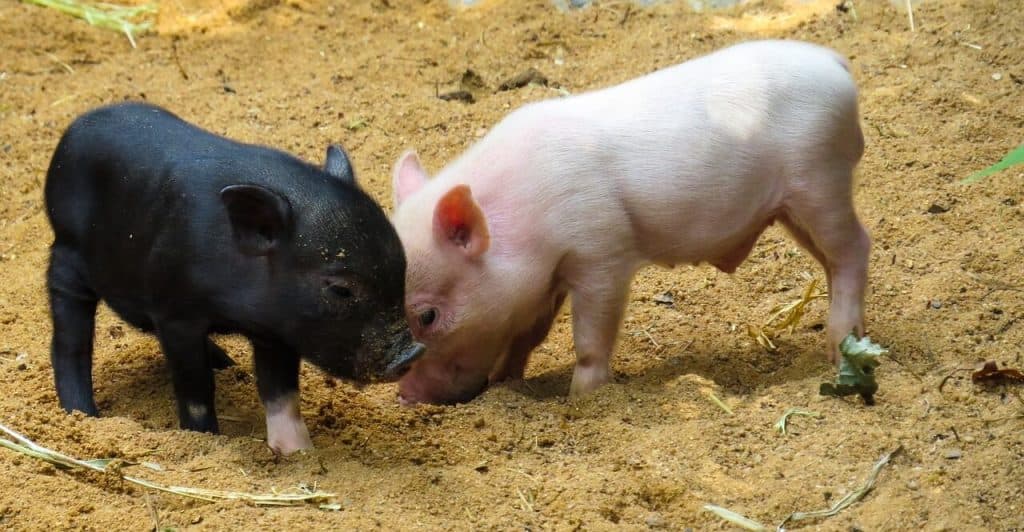Do you know where the term chicken pox came from? How about which farm animal is the closest living relative to the Tyrannosaurus Rex or what mental disease causes a man to think he is an ox? You can find the answer below as well as some other amazing facts that you might not have known about pigs, horses, cattle, chickens, turkeys, and sheep.
- The tongue of a pig has six thousand more taste buds than a human’s. Pigs have 15,000 while humans only have 9,000.
- Pigs and light-colored horses are the only two mammals besides humans that can get sunburned.
- Pigs have been rated as the fourth most intelligent animal in the world, and are believed to be as smart if not smarter than dogs.
- In truth, “to sweat like a pig” would mean that you do not sweat at all. Pigs have no sweat glands.
- If a pig was able to fly, other pigs would be unable to see him. Pigs are incapable of looking up.
- The average horse eats seven times its own weight in food each year.
- Horses live about thirty years. However, an English barge horse named “Old Billy” was sixty-two years old when he died and is the oldest recorded horse.
- If a female horse and a male donkey mate, the offspring is known as a mule. If a male horse and a female donkey mate, the offspring is known as a hinny. Both mules and hinnies are usually sterile.
- The number of hooves raised on a horse statue does not indicate how the rider died. The common belief was that two legs raised indicated the person died in battle, one leg raised indicated the person died of wounds they received in battle, and no legs raised indicated the person died of natural causes. However, this belief can be applied to most of the statues located at Gettysburg National Park.
- In Columbia, a cow once committed murder after it stepped on a loaded rifle and shot another cow in the head.
- Cows are color blind. Bulls charge a matador’s cape because it is moving, not because it is red.
- There are more cows in the United States than people. New Zealand has more sheep than people. They have 70 million sheep but only 40 million people.
- Cows produce about thirty percent of the methane in the atmosphere.
- Twelve or more cows are known as a fink.
- A cow’s glands are located in its nose.
- Boanthropy is a rare mental disorder that causes a person to think he is an ox. One of the first recorded cases is in the book of Daniel (4:33), which tells about Nebuchadnezzar, a Babylonian king who would eat grass.
- Because of the way a cow’s legs bend, they are incapable of walking downstairs. However, they can walk upstairs.
- During her lifetime, a cow will produce about 200,000 glasses of milk. Cows will produce more milk when they are listening to music.
- A donkey’s eyes are placed so that it is able to see all four of its feet no matter which way it looks.
- More people are killed annually by donkeys, on average, then die in plane crashes.
- Russian breeders once claimed that they had produced a sheep with blue wool.
- Chickens are not very good at flying. The longest recorded flight of a chicken is only thirteen seconds. The longest recorded distance flown by a chicken is 301.5 feet.
- Scientists believe that the closest living relative to the Tyrannosaurs Rex is the chicken.
- There is approximately the same amount of chickens as there are people with the most of each species living in China, which has about three billion chickens. The U.S. has only about 450 million chickens.
- An egg’s shell is determined by the breed of chicken. Not all chicken eggs are white or brown; some chickens, such as the Ameraucana and the Araucana, produce blue and green eggs. The color of the yolk, however, can be affected by the chicken’s diet. Feeding certain dyes to chickens can cause them to lay eggs with varicolored yolks.
- The term “chicken pox” comes from the Old English term “gican pox,” which referred to an itching pox, not because people believed the illness was caused by chickens.
- Chickens and turkeys are capable of crossbreeding. When they do, they produce offspring that are known as turkins.
- Although the turkey originated in North and Central America around 10 million years ago, it was mistakenly named after what was believed to be its country of origin.
- Most domestic turkeys are incapable of flying. Wild turkeys can, however, and are capable of reaching speeds of fifty-five miles per hour for short distances. They can also run up to twenty-five miles per hour.
- Equinophobia is the fear of horses; alektorophobia is the fear of chickens; and taurophobia is the fear of bulls. There is no official term for the fear of cows or pigs.
Knowing all this puts a new light on Old McDonald’s farm now, doesn’t it? Of course, you rarely heard about the turkins, hinnies, or modern dinosaurs there.
By Darcy Logan
Advertisement - Story continues below
Request advertising info. View All.
